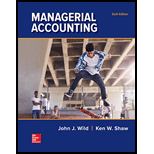
Managerial Accounting
6th Edition
ISBN: 9781259726972
Author: John J Wild, Ken W. Shaw, Barbara Chiappetta Fundamental Accounting Principles
Publisher: McGraw-Hill Education
expand_more
expand_more
format_list_bulleted
Textbook Question
Chapter 13, Problem 16E
Exercise
Interpreting financial ratios
Refer to the information in Exercise 13-15.
1. Which company has the better («) profit margin, (b) asset turnover, and (c) return on assets?
2. Which company has the better rate of growth in sales?
3. Did Rid successfully use financial leverage in the current year? Did Clay?
Expert Solution & Answer
Want to see the full answer?
Check out a sample textbook solution
Students have asked these similar questions
Please provide the correct answer to this general accounting problem using valid calculations.
Under absorption costing the ending inventory for the year would be valued at:
I am searching for the accurate solution to this financial accounting problem with the right approach.
Chapter 13 Solutions
Managerial Accounting
Ch. 13 - Prob. 1MCQCh. 13 - Prob. 2MCQCh. 13 - Prob. 3MCQCh. 13 - Prob. 4MCQCh. 13 - Prob. 5MCQCh. 13 - Prob. 1DQCh. 13 - Prob. 2DQCh. 13 - Prob. 3DQCh. 13 - Prob. 4DQCh. 13 - Prob. 5DQ
Ch. 13 - Prob. 6DQCh. 13 - Prob. 7DQCh. 13 - Prob. 8DQCh. 13 - Prob. 9DQCh. 13 - Prob. 10DQCh. 13 - Prob. 11DQCh. 13 - Prob. 12DQCh. 13 - Where on the income statement does a company...Ch. 13 - Prob. 14DQCh. 13 - Prob. 15DQCh. 13 - Samsung Refer to Samsung’s financial statements in...Ch. 13 - Prob. 17DQCh. 13 - Prob. 1QSCh. 13 - Prob. 2QSCh. 13 - Prob. 3QSCh. 13 - Prob. 4QSCh. 13 - Prob. 5QSCh. 13 - Prob. 6QSCh. 13 - Prob. 7QSCh. 13 - Prob. 8QSCh. 13 - Prob. 9QSCh. 13 - Prob. 10QSCh. 13 - Prob. 11QSCh. 13 - Prob. 12QSCh. 13 - Prob. 13QSCh. 13 - Morgan Company and Parker Company are similar...Ch. 13 - Which of the following gains or losses would...Ch. 13 - Prob. 1ECh. 13 - Prob. 2ECh. 13 - Prob. 3ECh. 13 - Prob. 4ECh. 13 - Prob. 5ECh. 13 - Exercise 13-6 Common-size percents P2
Simon...Ch. 13 - Prob. 7ECh. 13 - Exercise 13-8 Liquidity analysis and...Ch. 13 - Exercise 13-9 Risk and Capital structure analysis...Ch. 13 - Exercise 13-10 Efficiency and Profitability...Ch. 13 - Exercise 13-11 profitability analysis P3 Refer to...Ch. 13 - Prob. 12ECh. 13 - Prob. 13ECh. 13 - Prob. 14ECh. 13 - Prob. 15ECh. 13 - Exercise Interpreting financial ratios Refer to...Ch. 13 - Prob. 17ECh. 13 - Prob. 18ECh. 13 - Prob. 1PSACh. 13 - Prob. 2PSACh. 13 - Prob. 3PSACh. 13 - Problem 13-4A Calculation of financial statement...Ch. 13 - Prob. 5PSACh. 13 - Prob. 6PSACh. 13 - Prob. 1PSBCh. 13 - Prob. 2PSBCh. 13 - Prob. 3PSBCh. 13 - Prob. 4PSBCh. 13 - Prob. 5PSBCh. 13 - Problem 13-6BAIncome statement computations and...Ch. 13 - Use the following selected data from Business...Ch. 13 - Use Apple’s financial statements in Appendix A to...Ch. 13 - Prob. 2AACh. 13 - Prob. 3AACh. 13 - Prob. 1BTNCh. 13 - Prob. 2BTNCh. 13 - Prob. 3BTNCh. 13 - Prob. 4BTNCh. 13 - ENTREPRENEURIAL DECISION A1 P1 P2 P3 BTN 13-7...Ch. 13 - Prob. 6BTN
Knowledge Booster
Learn more about
Need a deep-dive on the concept behind this application? Look no further. Learn more about this topic, accounting and related others by exploring similar questions and additional content below.Similar questions
- Please explain the solution to this financial accounting problem with accurate principles.arrow_forwardCan you solve this general accounting problem using appropriate accounting principles?arrow_forwardPlease provide the correct answer to this financial accounting problem using valid calculations.arrow_forward
- A company identifies two activities: material handling and machine setup. The cost drivers are number of parts (10,000) and number of setups (200), with cost pools of $250,000 and $180,000 respectively. Product A uses 2,500 parts and 50 setups. Calculate the activity-based overhead allocated to Product A.arrow_forwardCan you solve this financial accounting problem using appropriate financial principles?arrow_forwardQuestion 7-Barrow_forward
arrow_back_ios
SEE MORE QUESTIONS
arrow_forward_ios
Recommended textbooks for you
 Cornerstones of Financial AccountingAccountingISBN:9781337690881Author:Jay Rich, Jeff JonesPublisher:Cengage Learning
Cornerstones of Financial AccountingAccountingISBN:9781337690881Author:Jay Rich, Jeff JonesPublisher:Cengage Learning Intermediate Financial Management (MindTap Course...FinanceISBN:9781337395083Author:Eugene F. Brigham, Phillip R. DavesPublisher:Cengage Learning
Intermediate Financial Management (MindTap Course...FinanceISBN:9781337395083Author:Eugene F. Brigham, Phillip R. DavesPublisher:Cengage Learning Financial Accounting: The Impact on Decision Make...AccountingISBN:9781305654174Author:Gary A. Porter, Curtis L. NortonPublisher:Cengage Learning
Financial Accounting: The Impact on Decision Make...AccountingISBN:9781305654174Author:Gary A. Porter, Curtis L. NortonPublisher:Cengage Learning


Cornerstones of Financial Accounting
Accounting
ISBN:9781337690881
Author:Jay Rich, Jeff Jones
Publisher:Cengage Learning



Intermediate Financial Management (MindTap Course...
Finance
ISBN:9781337395083
Author:Eugene F. Brigham, Phillip R. Daves
Publisher:Cengage Learning

Financial Accounting: The Impact on Decision Make...
Accounting
ISBN:9781305654174
Author:Gary A. Porter, Curtis L. Norton
Publisher:Cengage Learning
How To Analyze an Income Statement; Author: Daniel Pronk;https://www.youtube.com/watch?v=uVHGgSXtQmE;License: Standard Youtube License